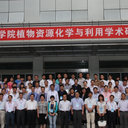[Spectrum-effect relationship on anti-hepatic fibrosis effect of Radix Hedysari].
Түлхүүр үгс
Хураангуй
The spectrum-effect relationship on anti-hepatic fibrosis effect of Radix Hedysari was explored based on high performance liquid chromatographic technique. Hepatic fibrosis was induced in mice by administering a subcutaneous injection of carbon tetrachloride-peanut oil (4:6, v/v) continuously for 35 d at a interval of 5 d (0.1 mL/10 g). And at the same time of modeling, the different extracts of Radix Hedysari were administered orally once daily at a dose of 10 g/kg. The ethanol extract of Radix Hedysari was specified to be most effective on anti-hepatic fibrosis by determining the levels of alanine aminotransferase, aspartate transami- nase, total-protein, albumin, albumin/globulin (ALT, AST, TP, ALB, and A/G) in serum and relative liver weight. Subsequently, the grey relational degree analysis and partial least squares analysis were employed to reveal the correlation between chromatographic fingerprint of ethanol extract of Radix Hedysari from 10 different geographical origins and its anti-hepatic fibrosis efficacy. The results suggest that most chemical constituents of Radix Hedysari have a high correlation with the effect of anti-hepatic fibrosis (> 0.8), which indicates that the effect is related to the various components in Radix Hedysari. Adenosine, calycosin and ononin in ethanol extract of Radix Hedysari have been identified separately among which adenosine and calycosin made the great contribution to the anti-hepatic fibrosis effect.



